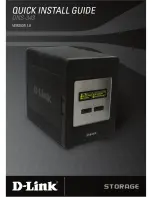
Chapter 19
| Quality of Service Commands
– 448 –
Default Setting
None
Command Mode
Policy Map Class Configuration
Command Usage
◆
You can configure up to 16 policers (i.e., class maps) for ingress ports.
◆
The
committed-rate
cannot exceed the configured interface speed, and the
committed-burst
cannot exceed 16 Mbytes.
◆
Policing is based on a token bucket, where bucket depth (i.e., the maximum
burst before the bucket overflows) is by specified the
committed-burst
field, and
the average rate tokens are added to the bucket is by specified by the
committed-rate
option. Note that the token bucket functions similar to that
described in RFC 2697 and RFC 2698.
◆
The behavior of the meter is specified in terms of one token bucket (C), the rate
at which the tokens are incremented (CIR – Committed Information Rate), and
the maximum size of the token bucket (BC – Committed Burst Size).
The token bucket C is initially full, that is, the token count Tc(0) = BC. Thereafter,
the token count Tc is updated CIR times per second as follows:
■
If Tc is less than BC, Tc is incremented by one, else
■
Tc is not incremented.
When a packet of size B bytes arrives at time t, the following happens:
■
If Tc(t)-B
≥
0, the packet is green and Tc is decremented by B down to the
minimum value of 0, else
■
else the packet is red and Tc is not decremented.
Example
This example creates a policy called “rd-policy,” uses the
class
command to specify
the previously defined “rd-class,” uses the
set phb
command to classify the service
that incoming packets will receive, and then uses the
police flow
command to limit
the average bandwidth to 100,000 Kbps, the burst rate to 4000 bytes, and configure
the response to drop any violating packets.
Console(config)#policy-map rd-policy
Console(config-pmap)#class rd-class
Console(config-pmap-c)#set phb 3
Console(config-pmap-c)#police flow 100000 4000 conform-action transmit
violate-action drop
Console(config-pmap-c)#
Summary of Contents for EX-3524
Page 2: ......
Page 28: ...Figures 28 ...
Page 34: ...Section I Getting Started 34 ...
Page 58: ...Chapter 1 Initial Switch Configuration Setting the System Clock 58 ...
Page 72: ...Chapter 2 Using the Command Line Interface CLI Command Groups 72 ...
Page 156: ...Chapter 5 SNMP Commands Notification Log Commands 156 ...
Page 164: ...Chapter 6 Remote Monitoring Commands 164 ...
Page 218: ...Chapter 7 Authentication Commands Management IP Filter 218 ...
Page 268: ...Chapter 8 General Security Measures Port based Traffic Segmentation 268 ...
Page 292: ...Chapter 9 Access Control Lists ACL Information 292 ...
Page 312: ...Chapter 10 Interface Commands Power Savings 312 ...
Page 324: ...Chapter 11 Link Aggregation Commands Trunk Status Display Commands 324 ...
Page 366: ...Chapter 15 Address Table Commands 366 ...
Page 428: ...Chapter 17 VLAN Commands Configuring Voice VLANs 428 ...
Page 572: ...Chapter 25 IP Interface Commands IPv6 Interface 572 ...
Page 578: ...Section I Appendices 578 ...
















































